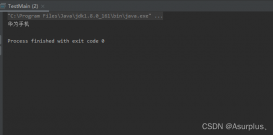一:简述
如果我们想要生成一个随机数,通常会使用Random类。但是在并发情况下Random生成随机数的性能并不是很理想,今天给大家介绍一下JUC包中的用于生成随机数的类--ThreadLocalRandom.(本文基于JDK1.8)
二:Random的性能差在哪里
Random随机数生成是和种子seed有关,而为了保证线程安全性,Random通过CAS机制来保证线程安全性。从next()方法中我们可以发现seed是通过自旋锁和CAS来进行修改值的。如果在高并发的场景下,那么可能会导致CAS不断失败,从而导致不断自旋,这样就可能会导致服务器CPU过高。
|
1
2
3
4
5
6
7
8
9
|
protected int next(int bits) { long oldseed, nextseed; AtomicLong seed = this.seed; do { oldseed = seed.get(); nextseed = (oldseed * multiplier + addend) & mask; } while (!seed.compareAndSet(oldseed, nextseed)); return (int)(nextseed >>> (48 - bits)); } |
三:ThreadLocalRandom的简单使用
使用的方法很简单,通过ThreadLocalRandom.current()获取到ThreadLocalRandom实例,然后通过nextInt(),nextLong()等方法获取一个随机数。
代码:
|
1
2
3
4
5
6
7
8
9
10
11
12
13
|
@Testvoid test() throws InterruptedException { new Thread(()->{ ThreadLocalRandom random = ThreadLocalRandom.current(); System.out.println(random.nextInt(100)); }).start(); new Thread(()->{ ThreadLocalRandom random = ThreadLocalRandom.current(); System.out.println(random.nextInt(100)); }).start(); Thread.sleep(100);} |
运行结果:

四:为什么ThreadLocalRandom能在保证线程安全的情况下还能有不错的性能
我们可以看一下ThreadLocalRandom的代码实现。
首先我们很容易看出这是一个饿汉式的单例
|
1
2
3
4
5
6
7
|
/** Constructor used only for static singleton */private ThreadLocalRandom() { initialized = true; // false during super() call}/** The common ThreadLocalRandom */static final ThreadLocalRandom instance = new ThreadLocalRandom(); |
我们可以看到PROBE成员变量代表的是Thread类的threadLocalRandomProbe属性的内存偏移量,SEED成员变量代表的是Thread类的threadLocalRandomSeed属性的内存偏移量,SECONDARY成员变量代表的是Thread类的threadLocalRandomSecondarySeed属性的内存偏移量。
|
1
2
3
4
5
6
7
8
9
10
11
12
13
14
15
16
17
18
19
|
// Unsafe mechanicsprivate static final sun.misc.Unsafe UNSAFE;private static final long SEED;private static final long PROBE;private static final long SECONDARY;static { try { UNSAFE = sun.misc.Unsafe.getUnsafe(); Class<?> tk = Thread.class; SEED = UNSAFE.objectFieldOffset (tk.getDeclaredField("threadLocalRandomSeed")); PROBE = UNSAFE.objectFieldOffset (tk.getDeclaredField("threadLocalRandomProbe")); SECONDARY = UNSAFE.objectFieldOffset (tk.getDeclaredField("threadLocalRandomSecondarySeed")); } catch (Exception e) { throw new Error(e); }} |
可以看到Thread类中确实有这三个属性
Thread类:
|
1
2
3
4
5
6
7
8
9
10
11
12
13
|
@sun.misc.Contended("tlr")//当前Thread的随机种子 默认值是0long threadLocalRandomSeed;/** Probe hash value; nonzero if threadLocalRandomSeed initialized */@sun.misc.Contended("tlr")//用来标志当前Thread的threadLocalRandomSeed是否进行了初始化 0代表没有,非0代表已经初始化 默认值是0int threadLocalRandomProbe;/** Secondary seed isolated from public ThreadLocalRandom sequence */@sun.misc.Contended("tlr")//当前Thread的二级随机种子 默认值是0int threadLocalRandomSecondarySeed; |
接下来我们看ThreadLocalRandom.current()方法。
ThreadLocalRandom.current()
ThreadLocalRandom.current()的作用主要是初始化随机种子,并且返回ThreadLocalRandom的实例。
首先通过UNSAFE类获取当前线程的Thread对象的threadLocalRandomProbe属性,看随机种子是否已经初始化。没有初始化,那么调用localInit()方法进行初始化
|
1
2
3
4
5
6
|
public static ThreadLocalRandom current() { // 获取当前线程的 if (UNSAFE.getInt(Thread.currentThread(), PROBE) == 0) localInit(); return instance; } |
localInit()
localInit()方法的作用就是初始化随机种子,可以看到代码很简单,就是通过UNSAFE类对当前Thread的threadLocalRandomProbe属性和threadLocalRandomSeed属性进行一个赋值。
|
1
2
3
4
5
6
7
8
|
static final void localInit() { int p = probeGenerator.addAndGet(PROBE_INCREMENT); int probe = (p == 0) ? 1 : p; // skip 0 long seed = mix64(seeder.getAndAdd(SEEDER_INCREMENT)); Thread t = Thread.currentThread(); UNSAFE.putLong(t, SEED, seed); UNSAFE.putInt(t, PROBE, probe); } |
接下来以nextInt()方法为例,看ThreadLocalRandom是如何生成到随机数的。我们可以看出随机数正是通过nextSeed()方法获取到随机种子,然后通过随机种子而生成。所以重点看nextSeed()方法是如何获取到随机种子的。
|
1
2
3
4
5
6
7
8
9
10
11
12
13
14
15
|
public int nextInt(int bound) { if (bound <= 0) throw new IllegalArgumentException(BadBound); int r = mix32(nextSeed()); int m = bound - 1; if ((bound & m) == 0) // power of two r &= m; else { // reject over-represented candidates for (int u = r >>> 1; u + m - (r = u % bound) < 0; u = mix32(nextSeed()) >>> 1) ; } return r; } |
nextSeed()
nextSeed()方法的作用是获取随机种子,代码很简单,就是通过UNSAFE类获取当前线程的threadLocalRandomSeed属性,并且将原来的threadLocalRandomSeed加上GAMMA设置成新的threadLocalRandomSeed。
|
1
2
3
4
5
6
|
final long nextSeed() { Thread t; long r; // read and update per-thread seed UNSAFE.putLong(t = Thread.currentThread(), SEED, r = UNSAFE.getLong(t, SEED) + GAMMA); return r; } |
小结:
ThreadLocalRandom为什么线程安全?是因为它将随机种子保存在当前Thread对象的threadLocalRandomSeed变量中,这样每个线程都有自己的随机种子,实现了线程级别的隔离,所以ThreadLocalRandom也并不需要像Random通过自旋锁和cas来保证随机种子的线程安全性。在高并发的场景下,效率也会相对较高。
注:各位有没有发现ThreadLocalRandom保证线程安全的方式和ThreadLocal有点像呢
需要注意的点:
1.ThreadLocalRandom是单例的。
2.我们每个线程在获取随机数之前都需要调用一下ThreadLocalRandom.current()来初始化当前线程的随机种子。
3.理解ThreadLocalRandom需要对UnSafe类有所了解,它是Java提供的一个可以直接通过内存对变量进行获取和修改的一个工具类。java的CAS也是通过这个工具类来实现的。
到此这篇关于java并发高的情况下用ThreadLocalRandom来生成随机数的文章就介绍到这了,更多相关java ThreadLocalRandom生成随机数内容请搜索服务器之家以前的文章或继续浏览下面的相关文章希望大家以后多多支持服务器之家!
原文链接:https://juejin.cn/post/7096686984189444104














